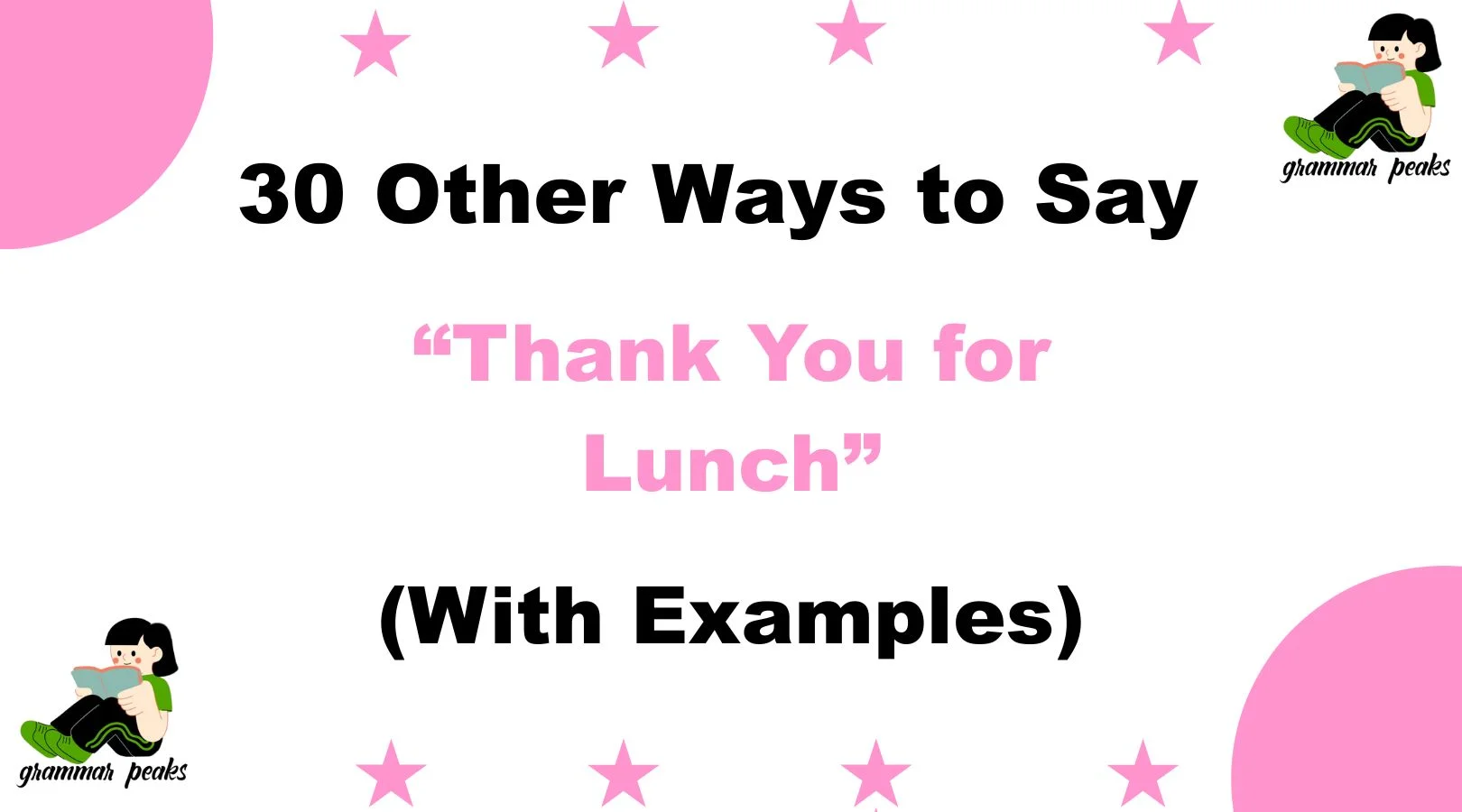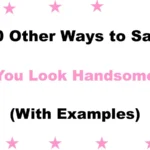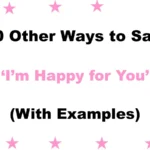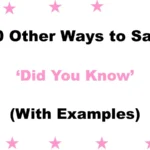Gratitude is more than just good manners—it’s a way to build relationships, show appreciation, and leave a lasting impression. Saying “Thank you for lunch” is polite, but it can sound repetitive or generic over time. Whether you’re thanking a colleague, friend, client, or date, the right words can make your appreciation feel more personal and memorable. This article offers 30 thoughtful, professional, and casual alternatives to help you say “thank you for lunch” in a more meaningful and engaging way.
What Does “Thank You for Lunch” Mean?
It’s a simple expression of appreciation for someone treating you to or sharing a meal with you—often during lunch hours. It acknowledges the gesture, effort, and time spent together.
When to Use “Thank You for Lunch”
You can say it after a casual meetup, business lunch, first date, or networking meal. It’s appropriate in emails, texts, follow-ups, or even a thank-you card.
Is It Polite or Professional to Say “Thank You for Lunch”?
Yes, it’s both polite and professional. However, using a more tailored version that suits the tone and relationship can leave a deeper impression. For example, a sincere or witty version can enhance a friendly vibe, while a polished phrase works better for professional interactions.
Pros and Cons of Saying “Thank You for Lunch”
Pros:
- Universally polite
- Easy to remember and use
- Works in casual and professional settings
Cons:
- Can sound bland or impersonal
- Lacks customization for context or relationship
- Missed opportunity to strengthen rapport
Synonyms For “Thank You for Lunch”
- I Really Appreciate Lunch Today
- Lunch Was Amazing—Thanks So Much!
- Thanks for the Great Meal
- I Really Enjoyed Lunch Today
- That Was Such a Thoughtful Gesture—Thank You
- Thanks for Taking the Time to Grab Lunch
- Appreciate You Treating Me to Lunch
- Thank You for the Delicious Lunch
- Thanks for Sharing Lunch with Me
- Grateful for the Company and the Food
- Thank You for a Lovely Lunch
- I’m So Grateful for the Lunch Invite
- That Meal Hit the Spot—Thanks Again!
- Appreciate You Making Time for Lunch
- Thanks for Catching Up Over Lunch
- Thank You for the Midday Break and Meal
- That Was Such a Generous Treat—Thank You
- I’m Honored You Took Me Out to Lunch
- Many Thanks for Today’s Lunch
- I’m Still Thinking About That Amazing Meal—Thanks!
- Thanks for the Delicious Midday Escape
- I Really Valued Our Lunch Chat—Thanks Again
- Thank You for Hosting Lunch Today
- Your Kindness at Lunch Meant a Lot
- Thanks for the Great Food and Better Conversation
- Thanks for Picking Such a Great Spot
- You’re Always the Best Lunch Date—Thanks!
- Appreciate the Meal and Your Time
- Thank You for Such a Tasty Break
- That Lunch Was Just What I Needed—Thanks a Ton
1. I Really Appreciate Lunch Today
Definition: Expresses heartfelt gratitude for the lunch.
Detailed Explanation: A warmer, slightly more emotional alternative to the standard phrase.
Scenario Example: “I really appreciate lunch today—it was great catching up with you.”
Best Use: With colleagues, friends, or informal professional settings.
Worst Use: When formality is expected.
Tone: Grateful, warm.
2. Lunch Was Amazing—Thanks So Much!
Definition: Combines gratitude with a compliment.
Detailed Explanation: A great way to show you enjoyed both the meal and the company.
Scenario Example: “Lunch was amazing—thanks so much for treating me!”
Best Use: After being hosted at a nice restaurant or homemade lunch.
Worst Use: In formal emails or messages.
Tone: Enthusiastic, casual.
3. Thanks for the Great Meal
Definition: A flexible phrase suitable for most social or casual business contexts.
Detailed Explanation: A versatile way to show appreciation without being overly formal or informal.
Scenario Example: “Thanks for the great meal—it was nice to catch up in person.”
Best Use: For networking lunches or client meetings.
Worst Use: None—it’s very neutral.
Tone: Polite, conversational.
4. I Really Enjoyed Lunch Today
Definition: Focuses on the experience rather than the gift.
Detailed Explanation: Suggests you valued the time together, not just the food.
Scenario Example: “I really enjoyed lunch today—thanks again for making time.”
Best Use: In thank-you emails or texts after business meetings.
Worst Use: If the lunch was rushed or awkward.
Tone: Appreciative, professional.
5. That Was Such a Thoughtful Gesture—Thank You
Definition: Emphasizes the generosity behind the lunch.
Detailed Explanation: Goes beyond food to recognize the intention.
Scenario Example: “That was such a thoughtful gesture—thank you for lunch.”
Best Use: When someone went out of their way to treat you.
Worst Use: In overly casual settings—it can feel too formal.
Tone: Gracious, reflective.
6. Thanks for Taking the Time to Grab Lunch
Definition: Acknowledges both the lunch and the shared time.
Detailed Explanation: Great for networking or catching up with a busy person.
Scenario Example: “Thanks for taking the time to grab lunch—I know how hectic your schedule is.”
Best Use: Professional networking or mentorship lunches.
Worst Use: Casual friend outings.
Tone: Respectful, professional.
7. Appreciate You Treating Me to Lunch
Definition: Directly thanks the person for paying.
Detailed Explanation: Best used when someone clearly covered the meal.
Scenario Example: “Appreciate you treating me to lunch—it was really generous.”
Best Use: When someone foots the bill or surprises you.
Worst Use: When the cost was shared or uncertain.
Tone: Casual, direct.
8. Thank You for the Delicious Lunch
Definition: Combines thanks with a compliment about the food.
Detailed Explanation: Works well for homemade meals or foodie experiences.
Scenario Example: “Thank you for the delicious lunch—I’m still thinking about that pasta!”
Best Use: After being invited to someone’s home or a special meal.
Worst Use: Generic fast food lunches.
Tone: Warm, sincere.
9. Thanks for Sharing Lunch with Me
Definition: A warm way to acknowledge both company and meal.
Detailed Explanation: Emphasizes companionship and quality time.
Scenario Example: “Thanks for sharing lunch with me—it meant a lot to catch up.”
Best Use: For old friends or family reunions.
Worst Use: When the lunch was highly transactional.
Tone: Emotional, nostalgic.
10. Grateful for the Company and the Food
Definition: A wholesome and appreciative phrase.
Detailed Explanation: A perfect balance between professionalism and personal warmth.
Scenario Example: “I’m grateful for the company and the food—thank you for today.”
Best Use: When the social connection matters as much as the meal.
Worst Use: When formality or brevity is required.
Tone: Heartfelt, genuine.
11. Thank You for a Lovely Lunch
Definition: A refined, classic way to express appreciation.
Detailed Explanation: “Lovely” softens the tone and adds a touch of charm, making it suitable for both social and semi-professional contexts.
Scenario Example: “Thank you for a lovely lunch—it was such a treat to connect in person.”
Best Use: For dates, client lunches, or catching up with a mentor.
Worst Use: When the interaction wasn’t enjoyable or felt forced.
Tone: Warm, elegant.
12. I’m So Grateful for the Lunch Invite
Definition: Thanks the person not just for the lunch, but for the invitation itself.
Detailed Explanation: Emphasizes your appreciation for being included.
Scenario Example: “I’m so grateful for the lunch invite—thank you again for making time.”
Best Use: Professional networking, business meals, or special events.
Worst Use: Super casual settings.
Tone: Appreciative, respectful.
13. That Meal Hit the Spot—Thanks Again!
Definition: A light and cheerful way to say thanks.
Detailed Explanation: Combines humor and satisfaction, showing personality.
Scenario Example: “That meal hit the spot—thanks again for lunch!”
Best Use: With colleagues or friends.
Worst Use: Formal or corporate settings.
Tone: Playful, casual.
14. Appreciate You Making Time for Lunch
Definition: Shows gratitude for the shared time more than the meal.
Detailed Explanation: Good for someone with a busy schedule.
Scenario Example: “Appreciate you making time for lunch today—it really meant a lot.”
Best Use: Managers, mentors, or executives.
Worst Use: Situations where time wasn’t an issue.
Tone: Professional, thoughtful.
15. Thanks for Catching Up Over Lunch
Definition: Emphasizes the value of the conversation.
Detailed Explanation: Great for friends or colleagues you haven’t seen in a while.
Scenario Example: “Thanks for catching up over lunch—it was just what I needed.”
Best Use: Reunions, updates, reconnecting.
Worst Use: First-time or formal meetings.
Tone: Friendly, relaxed.
16. Thank You for the Midday Break and Meal
Definition: A unique way to express gratitude for the pause and nourishment.
Detailed Explanation: Works when you needed a breather from a busy day.
Scenario Example: “Thank you for the midday break and meal—it really recharged me.”
Best Use: Busy workdays, mental health breaks, or thoughtful gestures.
Worst Use: Routine lunches.
Tone: Sincere, mindful.
17. That Was Such a Generous Treat—Thank You
Definition: Specifically acknowledges generosity.
Detailed Explanation: Works well when someone covered an expensive or unexpected lunch.
Scenario Example: “That was such a generous treat—thank you for including me.”
Best Use: High-end meals, surprise lunches.
Worst Use: Shared tabs or informal meals.
Tone: Respectful, gracious.
18. I’m Honored You Took Me Out to Lunch
Definition: Shows deep appreciation and humility.
Detailed Explanation: Suitable when a senior, VIP, or admired peer invites you.
Scenario Example: “I’m honored you took me out to lunch—thank you for the opportunity to chat.”
Best Use: High-stakes networking or leadership-level invitations.
Worst Use: With peers or in casual settings.
Tone: Formal, deferential.
19. Many Thanks for Today’s Lunch
Definition: A brief but warm way to say thank you.
Detailed Explanation: Keeps it short and sweet while staying polite.
Scenario Example: “Many thanks for today’s lunch—I enjoyed the time and conversation.”
Best Use: Email follow-ups or after-meeting notes.
Worst Use: Deeply personal or emotional moments.
Tone: Professional, crisp.
20. I’m Still Thinking About That Amazing Meal—Thanks!
Definition: Adds a memorable compliment to your gratitude.
Detailed Explanation: Makes your appreciation stand out.
Scenario Example: “I’m still thinking about that amazing meal—thanks again!”
Best Use: Great food, special outings.
Worst Use: Forgettable meals or casual grab-and-gos.
Tone: Lively, memorable.
21. Thanks for the Delicious Midday Escape
Definition: A creative way to acknowledge lunch as a break from the day.
Detailed Explanation: Suggests the experience was refreshing and enjoyable.
Scenario Example: “Thanks for the delicious midday escape—definitely needed that.”
Best Use: Stressful days or lunch as a mental reset.
Worst Use: Formal or professional settings.
Tone: Relaxed, fun.
22. I Really Valued Our Lunch Chat—Thanks Again
Definition: Acknowledges the quality of the conversation.
Detailed Explanation: Suitable when the meal was more about the talk than the food.
Scenario Example: “I really valued our lunch chat—thanks again for taking the time.”
Best Use: Mentorship, deep convos, networking.
Worst Use: Superficial or brief interactions.
Tone: Thoughtful, sincere.
23. Thank You for Hosting Lunch Today
Definition: Acknowledges both the invite and hospitality.
Detailed Explanation: Ideal when someone provided the space and meal.
Scenario Example: “Thank you for hosting lunch today—it was a wonderful experience.”
Best Use: Lunch at someone’s home or office.
Worst Use: Public or neutral spaces.
Tone: Polite, respectful.
24. Your Kindness at Lunch Meant a Lot
Definition: Highlights emotional appreciation, not just the meal.
Detailed Explanation: Shows the gesture made an impact.
Scenario Example: “Your kindness at lunch meant a lot—thank you for being there.”
Best Use: Emotional support, thoughtful gestures.
Worst Use: Business-only scenarios.
Tone: Emotional, heartfelt.
25. Thanks for the Great Food and Better Conversation
Definition: Combines gratitude with a compliment.
Detailed Explanation: A perfect balance between light and meaningful.
Scenario Example: “Thanks for the great food and even better conversation—I enjoyed every minute.”
Best Use: Friends, dates, colleagues.
Worst Use: Formal emails or cold contacts.
Tone: Warm, witty.
26. Thanks for Picking Such a Great Spot
Definition: Recognizes effort in choosing a restaurant.
Detailed Explanation: Shows appreciation beyond just the food.
Scenario Example: “Thanks for picking such a great spot—I had a fantastic time.”
Best Use: When they selected the venue.
Worst Use: Take-out or delivery.
Tone: Casual, observant.
27. You’re Always the Best Lunch Date—Thanks!
Definition: Playful, affectionate praise.
Detailed Explanation: Great for close relationships or ongoing lunch traditions.
Scenario Example: “You’re always the best lunch date—thanks for making my day.”
Best Use: Friends, partners, teammates.
Worst Use: Professional settings.
Tone: Friendly, fun.
28. Appreciate the Meal and Your Time
Definition: Values both food and time.
Detailed Explanation: Good for busy professionals or tight schedules.
Scenario Example: “Appreciate the meal and your time—let’s do it again soon.”
Best Use: Busy colleagues or mentors.
Worst Use: Long, leisurely lunches.
Tone: Polished, efficient.
29. Thank You for Such a Tasty Break
Definition: Blends gratitude with humor and energy.
Detailed Explanation: Works when you want to keep things light and breezy.
Scenario Example: “Thank you for such a tasty break—I feel refreshed already!”
Best Use: Lighthearted meetings or casual coworkers.
Worst Use: Serious or formal occasions.
Tone: Playful, breezy.
30. That Lunch Was Just What I Needed—Thanks a Ton
Definition: Sincere, casual appreciation.
Detailed Explanation: Suggests the meal had a meaningful or restorative effect.
Scenario Example: “That lunch was just what I needed—thanks a ton!”
Best Use: After a stressful day or personal moment.
Worst Use: Strictly professional environments.
Tone: Honest, casual.
Frequently Asked Questions (FAQs)
Is it professional to say “Thank you for lunch”?
Yes, it’s completely professional. In business or workplace settings, thanking someone for lunch is polite and courteous. However, choosing a more tailored phrase can sound more thoughtful and leave a lasting impression.
What is the best way to say thank you after a lunch meeting?
The best way is to be specific and genuine. Mention the lunch, appreciate the person’s time, and if possible, compliment the food or conversation. Example: “Thanks so much for lunch today—great food and even better insights.”
Should I send a follow-up thank-you message after lunch?
Absolutely. A quick thank-you email or message shows professionalism, reinforces your appreciation, and can help build or maintain a strong relationship.
Can I say “Thanks for the lunch” in casual situations?
Yes, “Thanks for the lunch” is fine casually. But adding warmth or a personal touch—like “Thanks for lunch, I really enjoyed it!”—makes it more impactful.
How do I say thank you for lunch in a romantic or personal context?
Go with something heartfelt or playful like: “You’re the best lunch date—thank you!” or “Lunch was perfect, and so was the company.”
Conclusion
Saying “Thank you for lunch” is a simple gesture that carries weight in both personal and professional circles. But why stop at the basics? By choosing an alternative that reflects your tone, relationship, and intention, you can turn a polite phrase into a moment of connection. Whether you’re networking, catching up, or showing appreciation, the right words make all the difference. Use these 30 alternatives to express sincere thanks in ways that feel fresh, authentic, and memorable—because gratitude should never feel robotic.

Mariah Cannon is a dedicated Senior Content Specialist at GrammarPeaks, known for her clear, engaging writing and deep knowledge of English grammar and usage. With a background in linguistics and years of experience in content development, Mariah crafts informative and accessible articles that empower readers to master the nuances of the English language. Her work reflects a commitment to clarity, education, and helping others express themselves with confidence.





